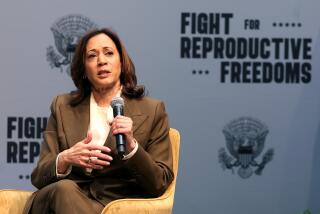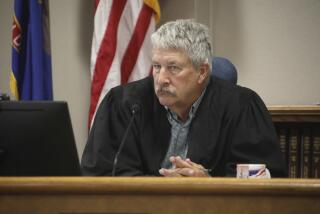Jane Hodgson, 91; doctor performed an abortion in 1970 to spur legal showdown
The woman who showed up at the office of Dr. Jane Hodgson had contracted rubella in the first month of her pregnancy and feared the baby would be born with deformities. She wanted an abortion.
In 1970 abortion was illegal in Minnesota, but Hodgson had treated a sad parade of patients -- bleeding, infected, mutilated victims of back-alley abortions -- and was convinced the law should be overturned.
Now, with this woman, a married mother of three, Hodgson could force a legal showdown on abortion.
After seeking permission from federal court and receiving no answer, Hodgson performed the procedure -- deliberately disobeying the law. A grand jury indicted the doctor, and a judge found her guilty.
It was a seminal moment in the push to legalize abortion in the United States, and a defining moment in the life of Hodgson, the first doctor in the United States to be convicted of illegally performing an abortion. Three years later the Supreme Court legalized abortion in its decision in Roe vs. Wade.
Hodgson died at her home Oct. 23 in Rochester, Minn., of complications from congestive heart failure, a family member said. She was 91.
The doctor’s decision to perform that abortion was “a catalyst for the entire movement” in Minnesota, said Tim Stanley, Planned Parenthood’s senior director of government and public affairs in the region that includes Minnesota.
“Certainly we had a vibrant community working to change the abortion statute in the state of Minnesota,” Stanley told The Times on Monday.
“It was a legislative argument until Dr. Hodgson really made it a legal imperative that this issue be faced, and then after that she quickly became this figure, a leader in our community around this issue.”
The judge in Hodgson’s case sentenced her to 30 days in jail and a year of probation. That ruling was still being appealed in 1973 when the U.S. Supreme Court handed down its decision in Roe vs. Wade.
Later Hodgson’s conviction was overturned.
Roe vs. Wade was the beginning of a fight that would last longer than Hodgson imagined.
“There was a movement, immediately, to reverse Roe vs. Wade, but I just kind of laughed at that and thought it could never happen,” she told a reporter for the Chicago Tribune in 1991. “An interesting phenomenon, though, that we didn’t count on, was that the hospitals (throughout the country) all started refusing to do abortions. Their boards would meet and decide not to do them (because of negative public reaction).”
The refusal of hospitals and individual doctors fearful of reaction to their performing the procedure means that women who live in certain parts of the nation have little access to abortion even though it is legal. The law means nothing, Hodgson often said, if women have no access.
The doctor spent a lifetime waging legal battles to preserve the law. At the age of 76, Hodgson continued to perform abortions, traveling 150 miles from her home, which was then in St. Paul, Minn., to Duluth, Minn., because doctors there refused.
“They really can’t get anybody else,” she told a reporter for the Houston Chronicle in 1992. “It’s ridiculous, really.... I think the young generation of medical students, with the exception of women, are not (interested in this training).
“And I don’t blame them, really. You’re really not going to beat your way through the pickets to help out in a clinic if they threaten your kids.”
Because Hodgson was financially self-sufficient -- she was married to Dr. Frank Quattlebaum -- she was able to work “for nothing, and I don’t have to worry about public approval,” she told the Chicago Tribune.
“If at any time I’ve ever had any doubt about what I’m doing, all I have to do is see a patient, and talk to her, and I realize it’s the right thing,” Hodgson told a reporter for the Washington Post in 1989.
Still, anti-abortion activists harassed the doctor with threatening letters, late-night phone calls and sometimes pickets at her home. To them she was a “baby killer” destined to burn in hell.
To many others Hodgson was a pioneer, not just in abortion rights but in reproductive healthcare as a whole, Stanley said.
“She was also a pioneer in giving women the services that they needed, regardless of what those were and without judgment,” he said.
Hodgson was born Jan. 23, 1915, in Crookston, Minn. As a child she accompanied her father, a rural physician, on visits to see patients.
In 1939 she earned her medical degree from the University of Minnesota and a year later married Quattlebaum. The couple had two children, who survive the doctor along with three grandchildren.
Over the years Hodgson remained deeply involved in the issue of abortion rights, writing, lecturing and debating on the issue.
She was a plaintiff in several cases in Minnesota challenging laws that would restrict a woman’s access to abortion, such as those that would require a teenager to receive permission from her parents before having the procedure.
“They don’t need consent for any other medical procedure,” she told the Washington Post reporter in 1989. “Here in Minnesota a girl can ... go through prenatal care and go through a Caesarean section without parental involvement. Treatment of venereal disease, treatment of AIDS ... this has just been singled out.”
Hodgson was deeply disappointed that the medical profession had remained silent instead of collectively declaring that abortion “is a medical procedure that is necessary for women’s health. It’s got to be provided, and it’s got to be provided safely.”
Although she was stunned by what she saw as declining access to abortion, she remained hopeful that gains would still be made and sustained.
“I have no question as to the ultimate outcome, but I just am terribly afraid I’m not going to be alive to see it,” she told a reporter for ABC’s “20/20” in 1991.
*
More to Read
Sign up for Essential California
The most important California stories and recommendations in your inbox every morning.
You may occasionally receive promotional content from the Los Angeles Times.










